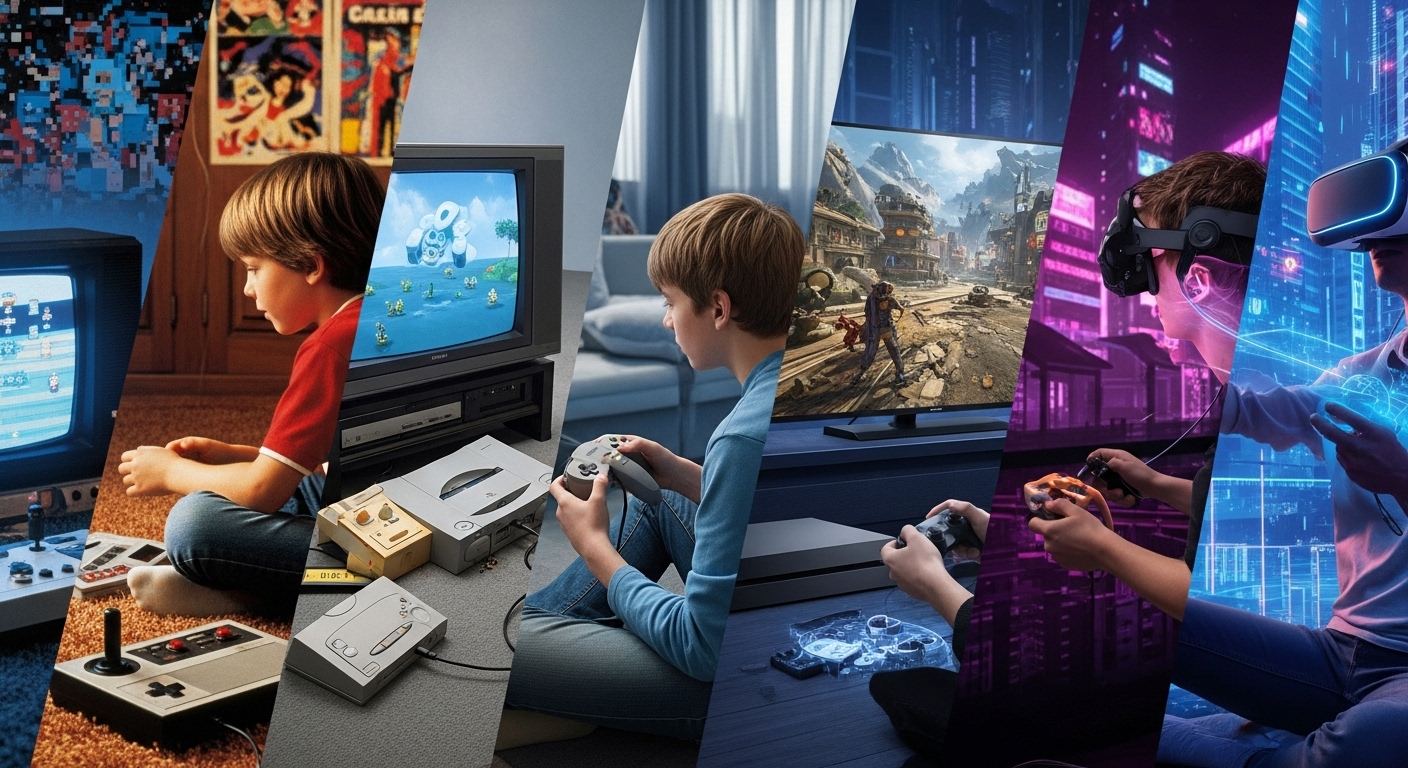Introduction: The Rise of a Digital Culture
Gaming is no longer a niche pastime reserved for a small group of enthusiasts. It has grown into a global cultural and economic powerhouse, shaping entertainment, technology, and even social interaction. What was once a simple diversion involving a few pixels bouncing around a screen has become an industry worth hundreds of billions of dollars. From the early arcade days to sprawling virtual worlds powered by artificial intelligence, gaming has evolved into one of the most dynamic and influential forms of art and storytelling in human history.
This evolution didn’t happen overnight. It’s the result of decades of innovation, competition, and creativity—driven by passionate developers and players alike. As technology advanced, so did the ways we experience games, from cartridges to cloud streaming, from single-player adventures to shared universes. Gaming has transcended the boundaries of entertainment to become an integral part of modern life.
The Early Years: Birth of the Arcade Age
The roots of gaming stretch back to the 1950s and 60s, when scientists and engineers began experimenting with computer programs that simulated simple games. But it wasn’t until the 1970s that gaming truly captured the public imagination. Titles like Pong and Space Invaders turned video games into a cultural phenomenon. Arcade halls became the gathering spots for young people around the world, filled with flashing lights, electronic music, and the thrill of competition.
These early games were simple, yet they had a unique charm. They didn’t rely on complex graphics or deep narratives—just engaging mechanics and instant gratification. The objective was often straightforward: score as many points as possible. Despite their simplicity, they demanded skill, timing, and reflexes. The limitations of the hardware forced developers to focus on gameplay, creating experiences that remain timeless even today.
The arcade era also gave rise to the concept of the “high score.” This idea—competing against friends or strangers to achieve the best score—laid the foundation for modern competitive gaming. It was a precursor to leaderboards, esports tournaments, and online rankings that dominate gaming culture today.
The Home Console Revolution
As technology advanced, the arcade slowly gave way to the home console. The 1980s saw the emergence of iconic systems such as the Atari 2600, Nintendo Entertainment System (NES), and Sega Master System. For the first time, people could experience high-quality games without leaving their living rooms.
Nintendo, in particular, became a household name. With franchises like Super Mario Bros., The Legend of Zelda, and Metroid, the company set a standard for creativity and design that continues to influence the industry. These games weren’t just entertainment; they were adventures filled with imagination, challenge, and wonder.
The 8-bit and 16-bit eras introduced gamers to vibrant worlds and unforgettable characters. Developers began to experiment with storytelling, art style, and soundtracks. Games like Final Fantasy, Mega Man, and Sonic the Hedgehog showcased the medium’s potential for emotional impact and artistic expression.
By the early 1990s, gaming had firmly established itself as a global industry. The competition between Nintendo and Sega, often referred to as the “console wars,” pushed both companies to innovate rapidly. This rivalry laid the groundwork for future advancements and solidified gaming as a permanent fixture of popular culture.
The Transition to 3D: A New Dimension of Play
The mid-1990s marked a pivotal turning point in gaming history: the transition from 2D sprites to fully realized 3D environments. The release of consoles like the Sony PlayStation, Nintendo 64, and Sega Saturn opened up a new realm of creative possibilities. Suddenly, players could explore worlds with depth, perspective, and realism never before imagined.
Games like Super Mario 64 and The Legend of Zelda: Ocarina of Time redefined what was possible in interactive entertainment. They offered vast, explorable environments and intricate gameplay systems. These titles weren’t just technological achievements; they represented a shift in how stories could be told through gaming.
The rise of 3D gaming also expanded the audience. Genres such as racing, first-person shooters, and role-playing games (RPGs) flourished in this new dimension. Developers began to experiment with camera angles, cinematic storytelling, and open-world design. What had once been a linear experience was now becoming something dynamic and immersive.
The Online Revolution: Connecting Players Across the Globe
The turn of the millennium introduced another game-changing innovation—online gaming. With the widespread availability of the internet, players could now compete, collaborate, and communicate in real time. Titles like Counter-Strike, World of Warcraft, and Halo 2 transformed gaming into a social experience.
This shift fundamentally changed how people interacted with games. No longer limited to local multiplayer or single-player campaigns, online play introduced virtual communities that transcended geographic boundaries. Friendships were formed, rivalries developed, and digital economies thrived within these new virtual worlds.
Massively multiplayer online role-playing games (MMORPGs) like World of Warcraft and Runescape offered endless adventures in living, breathing worlds. Players could create their own identities, embark on epic quests, and participate in vast player-driven ecosystems. Online gaming blurred the line between fantasy and reality, providing a sense of connection and belonging that was unmatched by any other medium.
The rise of broadband internet also paved the way for downloadable content, patches, and updates. Games were no longer static; they could evolve over time. This model laid the foundation for live-service games and digital distribution platforms that dominate today’s market.
The Age of High Definition and Realism
The mid-to-late 2000s brought another leap forward in technology. The release of the Xbox 360, PlayStation 3, and high-performance gaming PCs ushered in the high-definition era. Developers began to focus heavily on cinematic storytelling, realistic graphics, and complex gameplay systems.
Games like The Elder Scrolls V: Skyrim, Red Dead Redemption, and Uncharted 2 demonstrated how far the medium had come. With lifelike characters, emotional narratives, and breathtaking visuals, gaming was no longer seen merely as entertainment—it was recognized as an art form.
Advancements in motion capture, physics engines, and AI behaviors brought new levels of immersion. Developers could now create experiences that felt alive, where every detail mattered. Players weren’t just controlling characters; they were inhabiting them.
This period also saw the explosion of indie games. Independent developers, empowered by digital distribution platforms, began crafting innovative experiences that challenged conventions. Games like Braid, Undertale, and Journey proved that a small team with a strong vision could create deeply impactful works. The diversity of voices and ideas in gaming expanded dramatically, enriching the entire ecosystem.
The Mobile Gaming Explosion
When smartphones became mainstream, gaming experienced yet another transformation. Mobile games like Angry Birds, Clash of Clans, and Candy Crush Saga reached millions of players who had never considered themselves gamers before.
The accessibility of mobile gaming democratized the medium. You no longer needed a console or high-end PC—just a device that fit in your pocket. The free-to-play model and app store distribution made it easy for anyone to download and play.
While some critics dismissed mobile gaming as casual or superficial, its influence cannot be understated. It brought gaming to a wider demographic, including older adults and young children. It also introduced new business models, such as microtransactions and live events, that would reshape the industry’s economic landscape.
Moreover, mobile gaming served as a testing ground for innovation. Developers experimented with touch controls, augmented reality, and cross-platform play. Titles like Pokémon GO showcased how gaming could blend with the physical world, turning ordinary spaces into playgrounds of imagination.
The Rise of Esports: From Hobby to Professional Sport
What began as small-scale LAN parties has grown into a global phenomenon. Esports has become a billion-dollar industry, complete with professional leagues, sponsorships, and massive tournaments that fill stadiums.
Games like League of Legends, Dota 2, Counter-Strike: Global Offensive, and Fortnite have transformed competitive gaming into a spectator sport. Millions of fans tune in to watch their favorite teams and players compete for glory and life-changing prize pools.
Esports has also fostered a sense of legitimacy for gaming as a profession. Players train rigorously, follow strategic playbooks, and endure physical and mental challenges comparable to traditional athletes. The rise of streaming platforms has further amplified their reach, creating celebrities and influencers within the gaming community.
This new form of competition has not only redefined entertainment but also opened up career paths in coaching, commentary, event production, and marketing. The line between player and performer continues to blur as gaming evolves into both an art and a sport.
The Social Impact of Gaming
Beyond entertainment, gaming has become a powerful tool for social connection, education, and even therapy. Multiplayer games create communities where players share experiences, overcome challenges, and form lasting friendships.
Educational games and simulations are used in classrooms to teach subjects ranging from history to mathematics. Virtual reality has enabled immersive training environments for medicine, aviation, and engineering.
Gaming has also proven therapeutic for many. Titles that encourage creativity, relaxation, or problem-solving can reduce stress and anxiety. For individuals with disabilities, adaptive controllers and accessibility features have opened new doors to participation and enjoyment.
In recent years, gaming has even played a role in raising awareness and funds for social causes. Charity livestreams, in-game events, and fundraising campaigns have demonstrated the community’s power to make a positive impact on the world.
The Technology of Tomorrow: VR, AR, and AI
As we move deeper into the 21st century, the boundaries of gaming continue to expand. Virtual reality (VR) and augmented reality (AR) have unlocked new dimensions of immersion. With devices like the Meta Quest, PlayStation VR, and Apple Vision Pro, players can step directly into digital worlds that respond to their movements and gestures.
AI-driven storytelling and procedural generation are also reshaping game design. Developers can create adaptive experiences that respond dynamically to a player’s choices, making each playthrough unique. Games can now analyze behavior, adjust difficulty, and even generate new content on the fly.
The integration of cloud computing has made gaming more accessible than ever. With services that allow players to stream games without expensive hardware, the future of gaming is becoming more inclusive and flexible. You can start a game on your console, continue it on your phone, and finish it on your laptop—all seamlessly connected.
These advancements signal a future where gaming isn’t confined to screens. It will merge with our physical environments, powered by AI and enhanced by real-time interactivity. The dream of living inside your favorite game world is becoming a tangible reality.
The Cultural Influence of Gaming
Gaming’s impact now extends far beyond the confines of consoles and PCs. It influences fashion, film, music, and even politics. Characters like Mario, Lara Croft, and Master Chief have become pop culture icons, recognized across generations.
Game soundtracks are performed in concert halls. Adaptations like The Last of Us and Arcane have proven that game-based stories can achieve critical acclaim. Cosplay, fan art, and conventions have created vibrant subcultures that celebrate creativity and passion.
Moreover, gaming has influenced how we perceive narrative and interactivity. Unlike movies or books, games allow players to participate in the story. They empower us to make choices, face consequences, and experience emotions through action. This agency transforms storytelling from something we observe into something we live.
Challenges and Controversies
Despite its many achievements, the gaming industry is not without challenges. Issues such as crunch culture, microtransactions, and toxicity in online communities continue to spark debate.
Developers often face intense pressure to deliver ambitious projects on tight deadlines, leading to burnout and mental health struggles. Meanwhile, monetization strategies like loot boxes and pay-to-win mechanics have raised ethical concerns about exploitation and fairness.
Representation and inclusivity also remain key topics. While progress has been made, the industry continues to grapple with questions of diversity in both content and workforce. Games that embrace inclusivity—through meaningful characters, accessibility options, and respectful storytelling—tend to resonate more deeply with players.
As gaming grows more influential, it must also shoulder greater responsibility. The power to shape culture and behavior comes with the duty to promote empathy, respect, and ethical creativity.
The Future of Gaming: A Living Art Form
Looking ahead, gaming shows no signs of slowing down. With the convergence of AI, VR, and cloud computing, the next decade promises to redefine the very concept of play.
We’re moving toward experiences that adapt to us personally—games that understand our emotions, preferences, and playstyles. The line between creator and consumer will continue to blur, as players shape the worlds they inhabit through choices, creativity, and community.
In the near future, gaming could become as integral to communication as social media is today. Imagine virtual spaces where work, education, and play merge seamlessly—a shared digital existence that transcends distance and time zones.
Yet, amid all the technological marvels, one truth remains: at its heart, gaming is about stories, emotions, and connection. It’s about the joy of discovery, the thrill of challenge, and the shared experience of adventure. Whether you’re solving puzzles on your phone or exploring vast galaxies in VR, the essence of gaming lies in the human desire to play.
Conclusion: More Than Just a Game
From humble pixels to photorealistic worlds, from arcades to the metaverse, gaming’s journey has been extraordinary. It has evolved from a pastime into a culture, an art, and a way of life.
Gaming reflects who we are—our curiosity, creativity, and competitive spirit. It brings people together, transcending age, language, and geography. It challenges us to think, to feel, and to dream.
As technology continues to evolve, so too will the stories we tell and the worlds we build. The future of gaming is not just about better graphics or faster processors—it’s about expanding the boundaries of imagination and human connection.
In the end, gaming isn’t merely an escape from reality—it’s a mirror of it. It shows us what we can achieve when creativity, technology, and passion unite. And that is why gaming will continue to shape the future of entertainment, one pixel, one story, and one player at a time.


